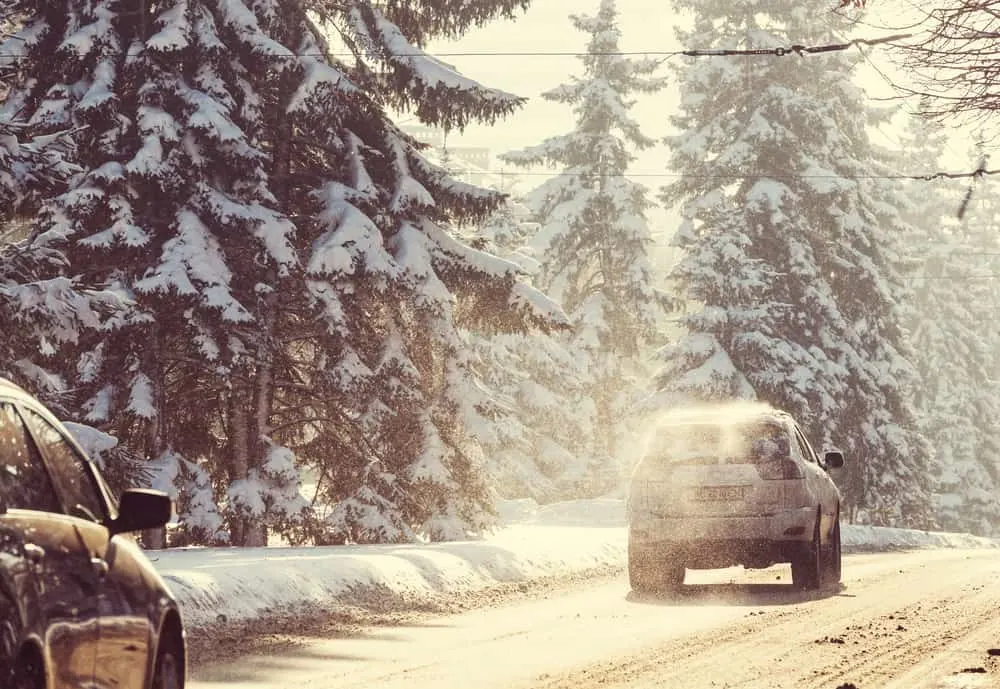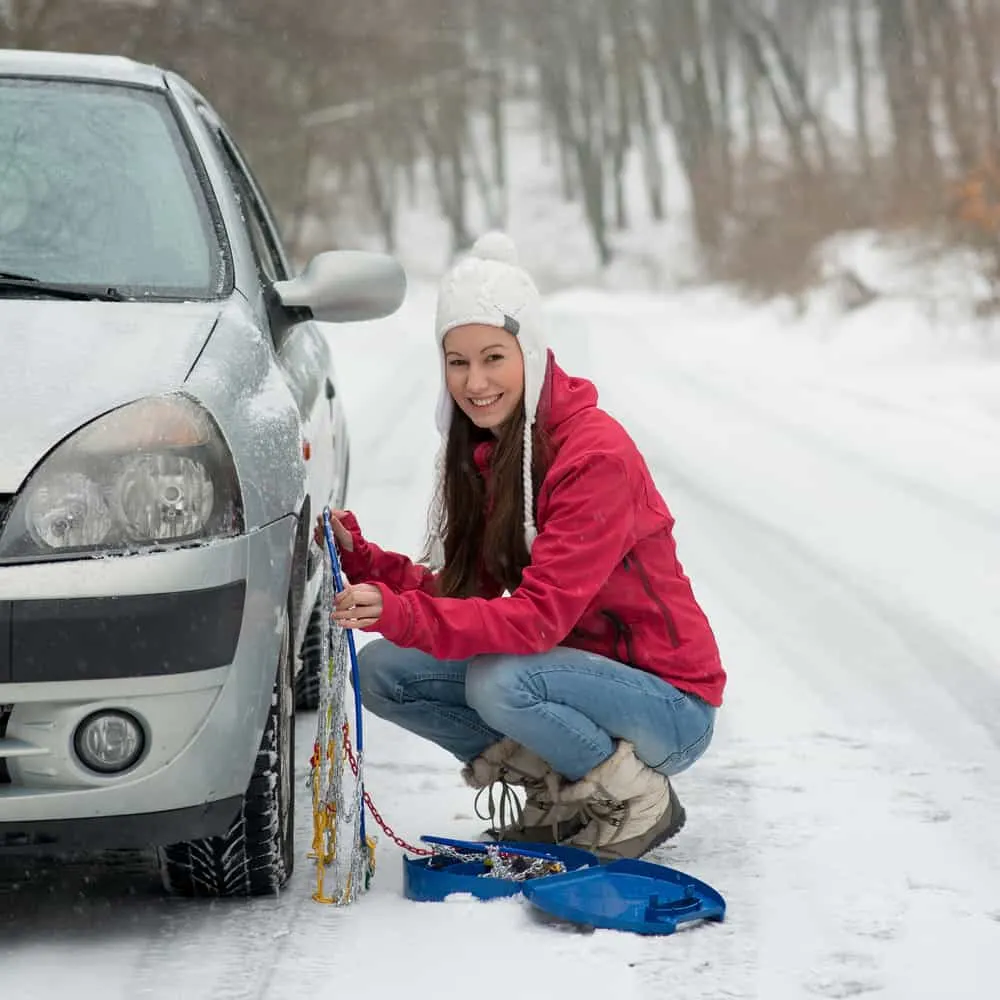While low-profile tires are great for increasing road grip, cutting fuel costs, and improving the overall look of your car, it can be challenging to know what snow chains are suitable for your wheels when snow begins to fall.
We have spent the past three months of wintery conditions checking out different snow chain brands to find out which are best suited to low profile tires.

How to Know If You Have Low Profile Tires
For anybody who doesn’t know much about automobiles, it can be tough to tell if your vehicle is currently equipped with low profile tires.
Many modern sports cars and some high-end sedans come outfitted with low profile tires as standard. Low profile tires have a shorter aspect ratio than other tires. An aspect ratio is measured by comparing a tire’s width to its height.
The easiest way to check if your car has low profile tires is by checking the code printed on its sidewall. For example, the code on your tire might read something like 205/45/R16.
The important number here when checking aspect ratio is the second along, which reads 45. As standard, any aspect ratio on a tire below 50 is considered a low profile.
By checking this number, you can save yourself from contacting a mechanic or having to consult your car’s manual before looking at whether you need snow chains suitable for low profile tires.
How To Check If Your Snow Chains are Suitable For Low Profile Tires
There are many factors to consider when checking if your snow chains are suitable for your low profile tires. The first thing to bear in mind with snow chains is they must apply them to all your drive wheels, meaning you will need four snow chains if your automobile has four-wheel drive.
Another crucial thing to check is whether you can use snow chains on your vehicle at all. Some manufacturers suggest not using snow chains on certain cars and trucks, as they may damage the tires or the automobile itself.
In which case, you will want to put winter tires on your vehicle instead, which will be much more expensive. Before equipping either winter tires or snow chains to your car or truck, you will want to check state regulations to see if any restrictions prohibit the use of snow chains or winter tires in certain conditions.
After considering these factors, you will want to examine a few things to make sure you don’t damage your tires or car when applying your snow chains.
One vital thing to check is whether there is enough clearance between your car and your tire when using snow chains. Low profile tires can be quite snug against your wheel arch, and if there is not enough space between the two, you will cause considerable damage to your vehicle when using snow chains.
In addition to the clearance, you will want to verify that your snow chains fit your tire’s aspect ratio, tread, and diameter. Luckily, many modern standard snow chains have been designed to fasten on to most tires. However, some are more effective than others, since not all snow chains are the same.
As low profile tires have shorter sidewalls, there is not as much space for snow chains to latch onto, so you will want to make sure your snow chains are correctly centered for maximum grip. A lot of modern snow chains are made to fasten on to most tire sizes and feature either manual tensioning or self-tensioning chains.
Manual tensioning chains will fasten to the wheel after you drive forward about 50 feet. You will just need to get out and pull the excess chain through the ratchet strap.
Self-tensioning chains are even more straightforward and tighten without the need to feed the leftover chain through the ratchet strap.
Keep in mind that because of how thin the sidewall is on low profile tires, it can be very easy to damage your tires when using snow chains.
If you are unsure of the best way to do this or whether you have enough clearance between the tire and the wheel arch, it is best to consult your local mechanic. Otherwise, you could have thousands of dollars in damages to your automobile.

The Benefits Of Snow Chains
The most obvious reason to use snow chains on your vehicle is to gain traction when driving on snowy and icy roads. They also work well on muddy roads.
You may find yourself having to put on and take off your snow chains several times during a drive around town, depending on the road conditions.
You will find that driving on recently plowed or gritted streets is not a good idea. Driving with snow chains on when there is not much snow will create potholes in the road and likely wreck your tires.
Snow chains can also be beneficial if you are taking a road trip up the mountains or to colder parts of the country. If you get caught a snowstorm or blizzard halfway up a mountain, snow chains could mean the difference between life and death.
When driving with snow chains in particularly dicey conditions, make sure you take it slow and steady. It is easy to overcompensate and undercompensate when steering on ice, even with snow tires.
If you are worried about installing your snow chains quickly in harsh conditions, it is best to practice taking your snow chains on and off at home, so you don’t get any nasty surprises while on the open road. Be sure to determine whether or not you need snow chains on all four tires or just two, before applying the devices.
Be sure to check out all of our helpful Emergency Preparedness articles for dealing with snow and ice.
Best Chains For Low Profile Tires
You will find a variety of different brands and types of snow chains on the market, which makes it tough to pick the best one for your low profile tires.
Here are a few examples of the best chains for low profile tires:
Security Chain Company SZ143 Super Z6 Cable Chain for Passenger Cars, Pickups, and SUVs
These snow chains are some of the most popular on the market and consist of metal cables that are suitable for all vehicle types, from SUVs to sports cars.
You will find these chains latch to your wheel with a designed-in rubber tightener, meaning you will not have to get out and readjust your tires or even move your vehicle to secure these snow chains.
These metal cables are thin compared to most snow chains, making them ideal for vehicles with little clearance and low profile tires. They are also reasonably priced so you won’t have to spend a lot of money.
Quality Chain Cobra Cable Passenger Snow Traction Tire Chains
Cobra Cable Now Traction Tire Chains are another example of a reasonably-priced, inventive take on the snow chain.
This snow chain features ladder-pattern cables, which are sleek and provide traction for vehicles with very little clearance.
While they may not be as durable as some traditional snow chains, they are unlikely to damage your wheel arch or your alloys, making them perfect for use on low-profile tires in moderately snowy conditions.
Thule Konig CG-9 Snow Chains
If you are looking for traditional and dependable snow chains for your low profile tires, consider the Konig CG-9 Snow Chains by Thule.
These chains feature a popular diamond-pattern design, which is often thought to be the best pattern for gaining traction in snowy conditions.
The chains also boast an incredibly durable nylon bumper so you will not damage your alloys despite their heavy-duty nature.
These chains are 9mm in thickness, which is relatively thin for durable snow chains. Just make sure you have enough clearance on your tires before purchasing.
VeMee Snow Chains
Innovative, easy to install, and inexpensive, VeMee Snow Chains are suitable for almost every vehicle. These fluorescent chains use tension straps to wrap around your wheel, making them easy to apply.
You can apply these straps one by one, making it easy and affordable to replace one if it breaks.
These straps are surprisingly durable and provide superb traction. Keep in mind that you shouldn’t perform sharp turns or hard braking while these snow chains are attached to your wheels.

